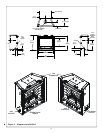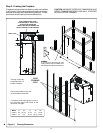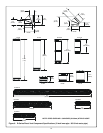
8
Approvals and
Codes
NOTE: THESE MODELS ARE UL LISTED TO UL307B,
THE STANDARD FOR GAS-BURNING HEATING APPLI-
ANCES FOR MANUFACTURED HOMES AND RECRE-
ATIONAL VEHICLES.
Installation Codes
The fireplace installation must conform to local codes. Before
installing the fireplace, consult the local building code
agency to ensure that you are in compliance with all
applicable codes, including permits and inspections.
In the absence of local codes, the fireplace installation must
conform to the National Fuel Gas Code ANSI Z223.1 (in
the United States) or the CAN/CGA-B149 Installation Codes
(in Canada). The appliance must be electrically grounded
in accordance with local codes or, in the absence of local
codes with the National Electric Code ANSI/NFPA No. 70
(in the United States), or to the CSA C22.1 Canadian Electric
Code (in Canada).
These models may be installed in a bedroom or bed-sitting
room in the U.S.A. and Canada.
Appliance Certification
The Village Collection fireplace models discussed in this
Installers Guide have been tested to certification standards
and listed by the applicable laboratories.
Certification
MODELS: QV32-A, QV36-A
LABORATORY: Underwriters Laboratories
TYPE: Vented Gas Fireplace Heater
STANDARD: ANSI Z21.88•CSA2.33•UL307B
High Altitude Installations
U.L. Listed gas fireplaces are tested and approved for
elevations from 0 to 2,000 feet in the U.S.A. and from 0 to
4,500 feet in Canada.
When installing this fireplace at an elevation above 2,000
feet (in the United States), it may be necessary to decrease
the input rating by changing the existing burner orifice to a
smaller size. Input should be reduced four percent (4%) for
each 1,000 feet above sea level, unless the heating value of
the gas has been reduced, in which case this general rule
will not apply. To identify the proper orifice size, check with
the local gas utility.
When installing this fireplace at an elevation between 2,000
and 4,500 feet (in Canada), the input rating must be reduced
by ten percent (10%).
When installing this fireplace at an elevation above 4,500
feet (in Canada), check with local authorities.
Consult your local gas utility for assistance in determining
the proper orifice for your location.


















